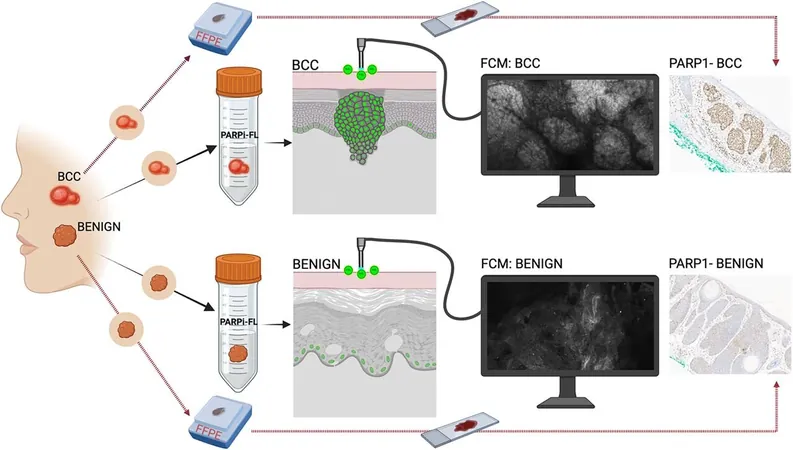
Game-Changing Imaging Technique Detects Skin Cancer in Just 5 Minutes!
2025-08-21
Author: Jia
Revolutionary Fluorescent Imaging for Early Skin Cancer Detection
In a breakthrough study published in The Journal of Nuclear Medicine, researchers have unveiled a groundbreaking fluorescent molecular contrast agent known as PARPi-FL, capable of spotting basal cell carcinoma (BCC) right through intact skin in as little as **five minutes**! This innovative technique promises rapid and safe detection using ex vivo human tissue, presenting a potential game-changer in skin cancer diagnostics.
The Challenge of Basal Cell Carcinoma
Basal cell carcinoma, the most prevalent form of skin cancer, typically yields excellent outcomes with early intervention. However, getting a definitive diagnosis often requires biopsies—painful and invasive procedures that can lead to scarring and unnecessary delays. Patients frequently wait weeks or even months for biopsy results before beginning treatment, increasing anxiety and prolonging the healing process.
A Leap Forward in Noninvasive Diagnostic Tools
Dr. Manu Jain, a research pathologist at Memorial Sloan Kettering Cancer Center, emphasized the need for noninvasive diagnostic tools with high accuracy to facilitate emerging nonsurgical therapies. This study explored the feasibility of using fluorescent confocal microscopy coupled with PARPi-FL for immediate BCC detection in clinical settings.
Study Highlights and Key Findings
Researchers rigorously tested various parameters, including optimal dose and application time, using human tissue samples from surgeries and fresh excisions. They also assessed the practicality of topical application via gauze and real-time imaging on tumor-bearing mice. Remarkably, a minimal dose of just **10 micromolar** applied for **two to five minutes** demonstrated adequate dermal penetration, allowing PARPi-FL to emit strong fluorescent signals in cancerous lesions while showing significantly weaker signals in benign tissue.
Safe and Effective: The Future of Skin Cancer Diagnosis?
Safety is paramount, and preclinical studies confirmed that PARPi-FL poses no significant risks for topical application. Dr. Ashish Dhir, a senior pharmacology expert, underscored the potential of this targeted dye to increase diagnostic accuracy and reduce unnecessary biopsies, paving the way for timely, noninvasive treatments for BCC.
Beyond Basal Cell Carcinoma: A Broader Impact?
Given that PARP1 is also prevalent in melanoma, these promising findings could extend beyond BCC, enabling this innovative approach to help differentiate between malignant and benign pigmented lesions without a biopsy. The implications for patient care and cancer management could be profound.
Conclusion: A New Era in Cancer Detection?
As researchers continue to refine this technique, the potential for PARPi-FL to reshape the landscape of skin cancer diagnostics becomes increasingly tangible. This development not only holds the promise of faster, stress-free diagnoses but also marks a significant step towards improving patient outcomes in the battle against skin cancer.


 Brasil (PT)
Brasil (PT)
 Canada (EN)
Canada (EN)
 Chile (ES)
Chile (ES)
 Česko (CS)
Česko (CS)
 대한민국 (KO)
대한민국 (KO)
 España (ES)
España (ES)
 France (FR)
France (FR)
 Hong Kong (EN)
Hong Kong (EN)
 Italia (IT)
Italia (IT)
 日本 (JA)
日本 (JA)
 Magyarország (HU)
Magyarország (HU)
 Norge (NO)
Norge (NO)
 Polska (PL)
Polska (PL)
 Schweiz (DE)
Schweiz (DE)
 Singapore (EN)
Singapore (EN)
 Sverige (SV)
Sverige (SV)
 Suomi (FI)
Suomi (FI)
 Türkiye (TR)
Türkiye (TR)
 الإمارات العربية المتحدة (AR)
الإمارات العربية المتحدة (AR)